Nvidia RTX 5070 vs AMD RX 9070 Face Off

Love them or hate them, the Nvidia RTX 5070 and AMD RX 9070 are two of the more affordable current-generation graphics cards you can buy from Team Red or Team Green for the time being (inflated pricing or not). At least that's true until the RX 9060 series debuts and the RTX 5060 goes truly mainstream and sells regularly at MSRP. In this face-off, we’ll pit the two latest '70 cards against each other to see which is the best option.
The RTX 5070 is Nvidia’s latest generation mid-range GPU solution, which is supposed to be sold at an MSRP of $549. But gamers, particularly in the U.S., will be hard-pressed to find a model selling at that price. The RTX 5070 shares many traits with its predecessor, the RTX 4070, featuring the same bus width and memory capacity, but a massive upgrade to GDDR7, boosting memory speeds to 28 Gbps. The process node used is also identical, but the RTX 5070 is taking advantage of Nvidia’s latest generation Blackwell architecture.
The AMD RX 9070 is a smaller sibling to the RX 9070 XT, sporting the same MSRP as the RTX 5070 and similar availability problems, despite there reportedly being significantly more cards in circulation, at least at launch. The RX 9070 comes with AMD’s latest RDNA4 architecture and is considerably faster than its predecessor, the RX 7800 XT. Helping its performance is the fact that it shares the same memory specs and performance as its bigger brother. The main attributes AMD limited on the vanilla 9070 are the core count and clock speeds (compared to the 9070 XT).
Pricing
In a perfect world, we would be comparing the RX 9070 and RTX 5070 at MSRP, but that isn't reality, and we don't know when availability will reach a point where cards will be regularly stocked at MSRP.
All we can report on is today's pricing. In the states, the RTX 5070 is more readily available, with AIB partner cards available at roughly $60-$70 over MSRP. By contrast, the cheapest RX 9070 we could find as of this writing was marked up $150 above MSRP. Both GPUs have an MSRP of $550.
This is compounded by the number of SKUs each GPU has. The RTX 5070 has significantly more options to choose from, and thus more models available near MSRP. The RX 9070 has relatively few models to choose from, with the PowerColor Hellhound OC being the only model at the moment that's anywhere near MSRP.
🏆 Winner: Nvidia
Get Tom's Hardware's best news and in-depth reviews, straight to your inbox.
For now, the RTX 5070 is the winner in this round, due to its better availability and its current pricing. But in a better world, this part of the face-off would be a tie since both GPUs have the same MSRP.
Performance
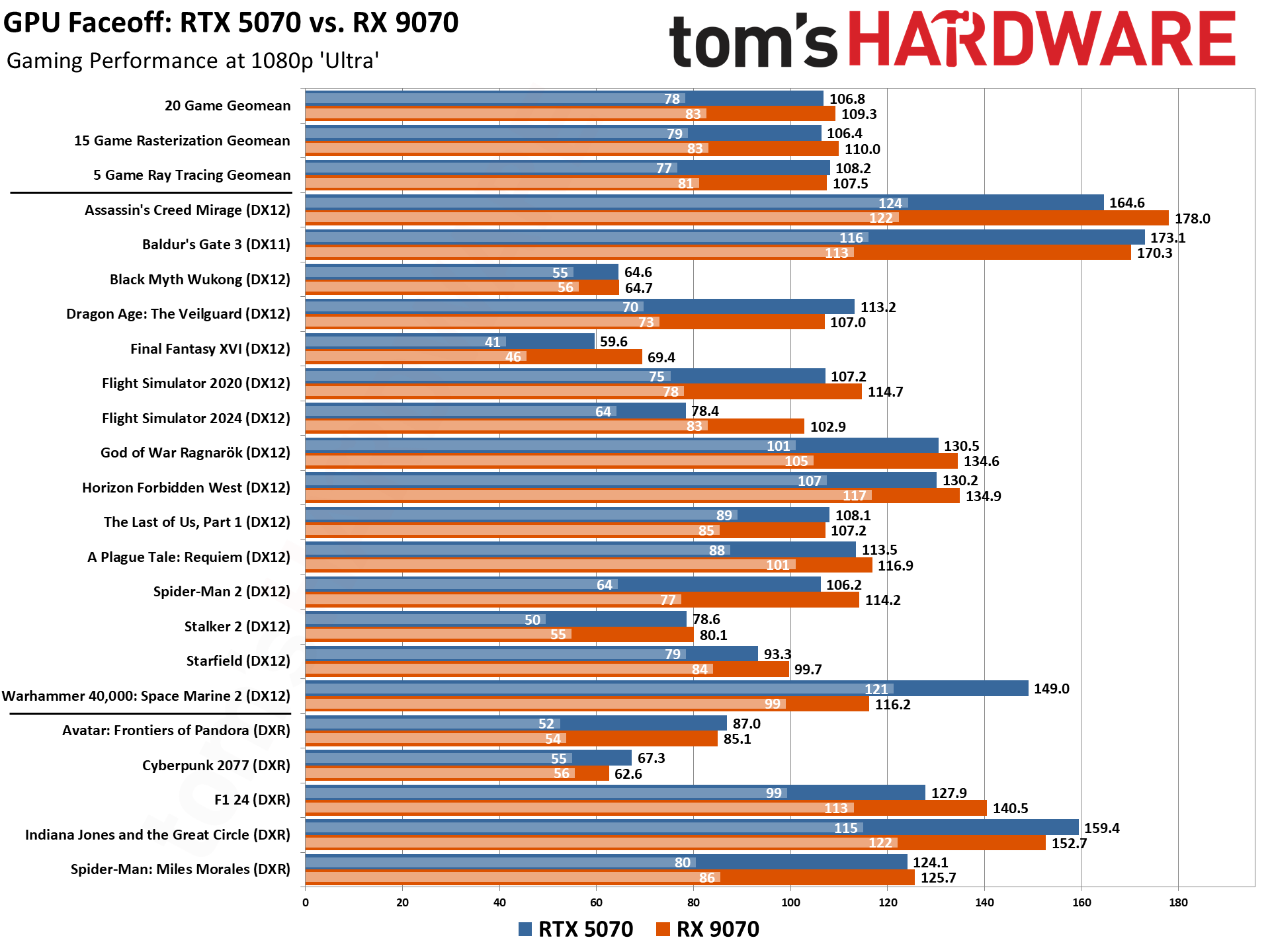

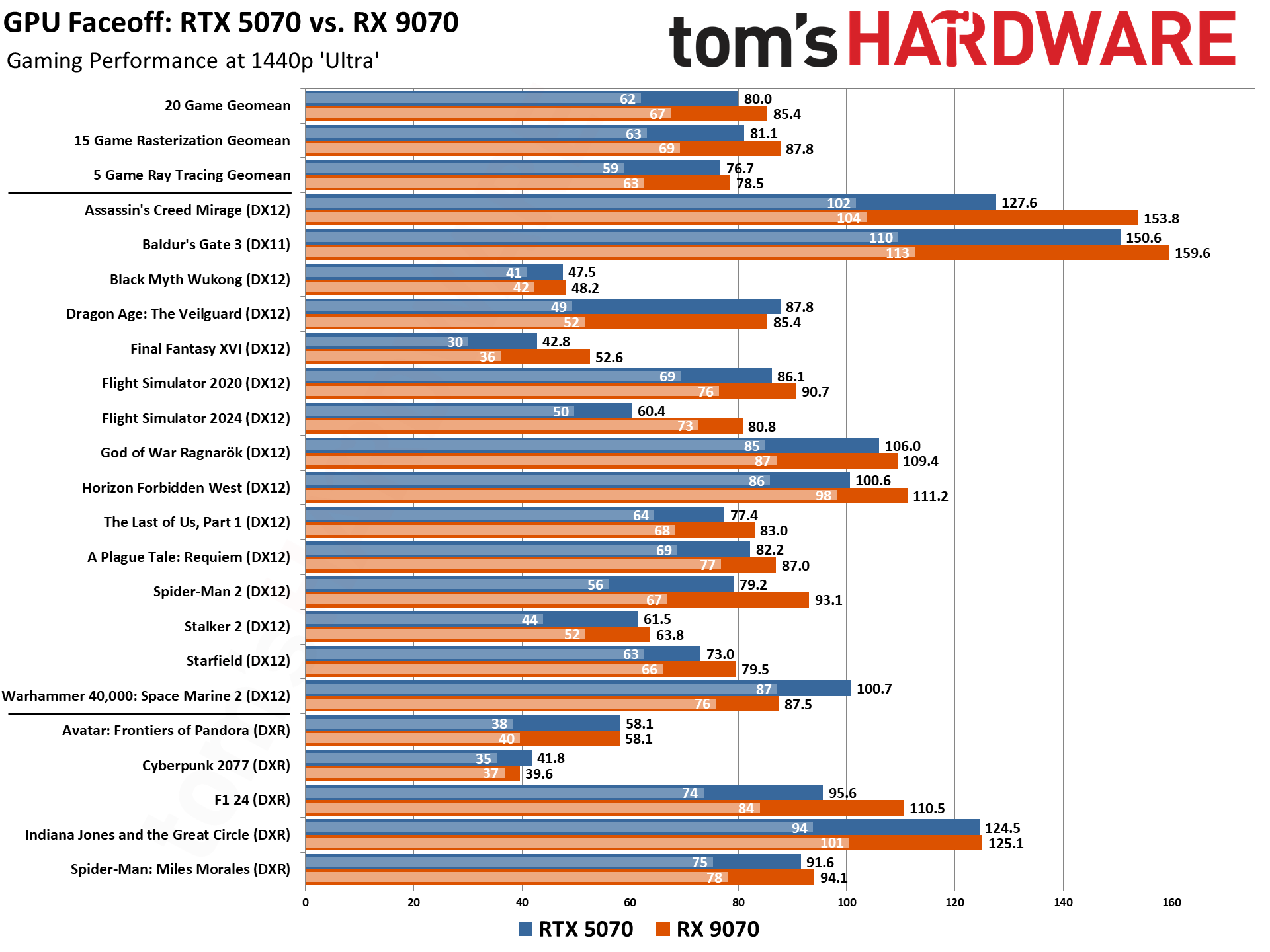
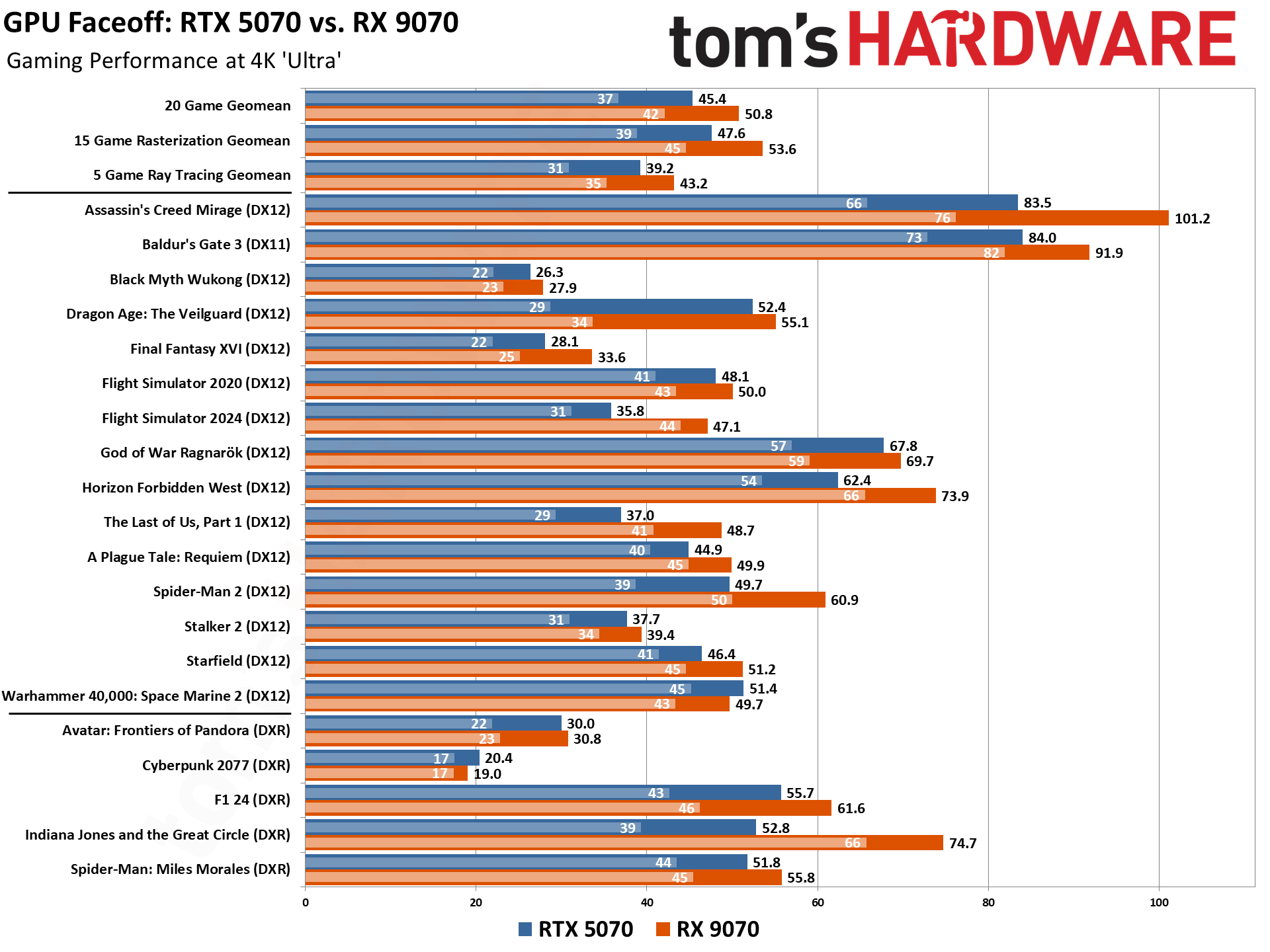
Overall performance between the RTX 5070 and RX 9070 is surprisingly close, even in ray tracing workloads at 1080p and 1440p. 1080p gaming is where the two GPUs are closest overall, with virtually indistinguishable performance on average across all of our games. Surprisingly, the RX 9070 starts to pull ahead at 1440p and takes a noteworthy lead at 4K resolution, despite relying on inferior GDDR6 memory and having a technically inferior (albeit slight) memory bandwidth handicap.
The 1080p ultra results are nearly neck and neck between the two GPUs in our three geomeans. At best, the RX 9070 pulls out a 0.33% win in our 15-game rasterization geomean. Moving on to some examples of per-game performance, Final Fantasy XVI (DX12) is 16% faster, and Microsoft Flight Simulator 2024 (DX12) is 31% quicker on the RX 9070. Conversely, the RTX 5070 has a monster 28.2% performance lead in Warhammer 40,000: Space Marine 2, likely due to unoptimized drivers from AMD for the RX 9070.
Thanks to RDNA4’s massive advancements in ray tracing capabilities, the RX 9070 runs in the same ballpark as the RTX 5070. In F1 24, the RX 9070 outperforms the RTX 5070 by a noteworthy 9%.
1080p medium shows a very slight performance bias towards the RX 9070. For example, the RX 9070 is 6% faster in our 15-game geomean. One interesting twist is that Indiana Jones and the Great Circle runs noticeably faster on the RX 9070 when tuned down to medium settings, outperforming the RTX 5070 by 11%. At ultra settings, the RTX 5070 is actually slightly faster in the same title.
Moving to 1440p reveals a slight performance bias towards the RX 9070, except in Ray Tracing benchmarks. Our 15-game rasterization geomean demonstrates an 8.2% lead in favor of the RX 9070, but our ray tracing geomean shows a mere 0.23% lead for the RDNA 4 GPU. Per game performance bias is similar to 1080p, although AMD makes a major comeback in Warhammer 40,000: Space Marine 2, with the RTX 5070 being “only” 15% quicker than the RX 9070 rather than 28.2%.
4K Ultra is where the RX 9070 really starts to pull away from the RTX 5070. Across all three of our geomeans, the RX 9070 was on average 11% quicker than the RTX 5070 (including ray tracing). The only two games where the RTX 5070 edged out the RX 9070 were Warhammer 40,000: Space Marine 2 (DX12) and Cyberpunk 2077 (DXR), with an extremely slim margin. Games where the RX 9070 excelled the most were MSFS 2024 (DX12), The Last of Us, Part 1 (DX12), and Indiana Jones and the Great Circle (DXR), by 31.5%, 31.6%, and 41.4%, respectively.
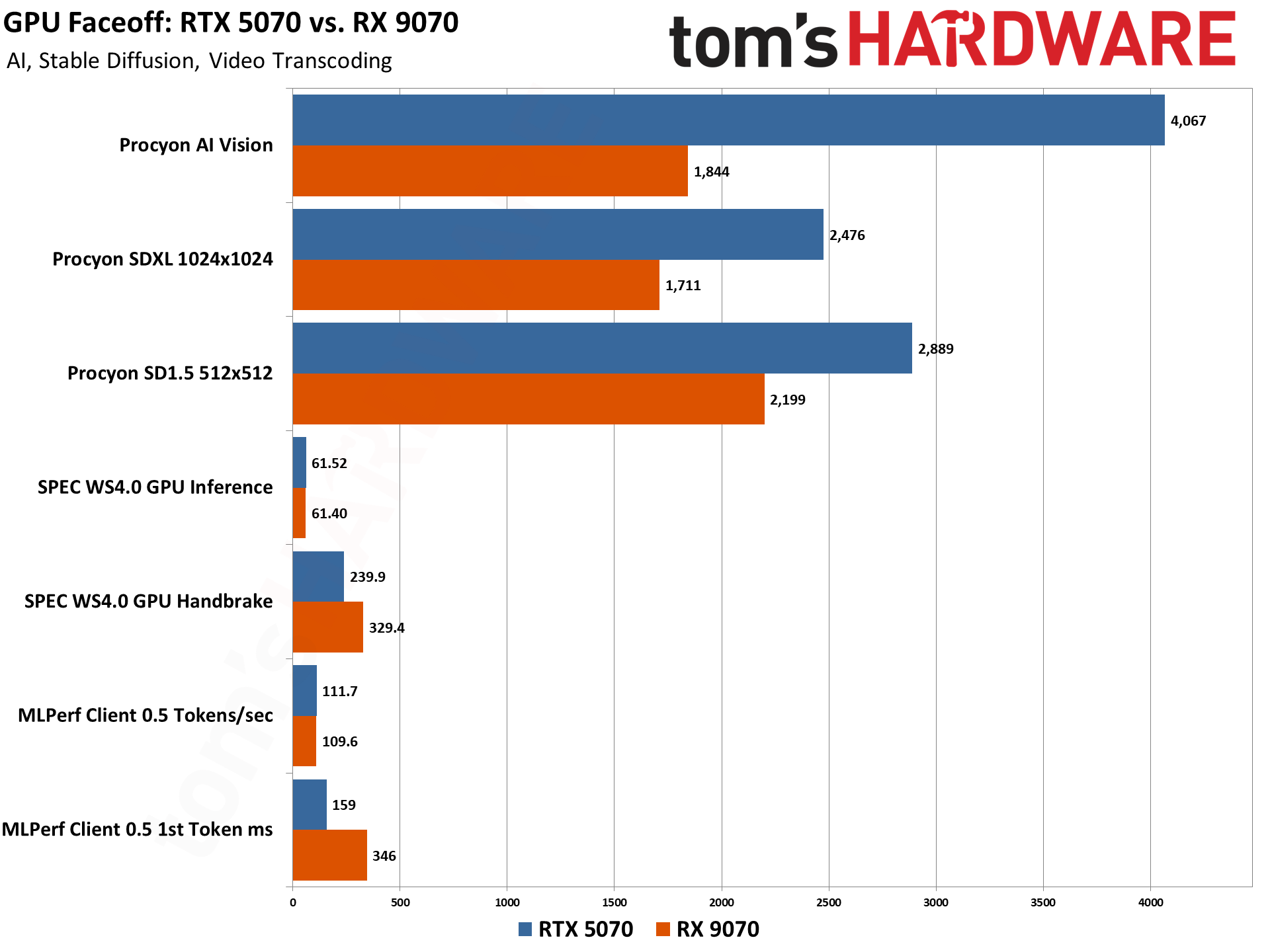
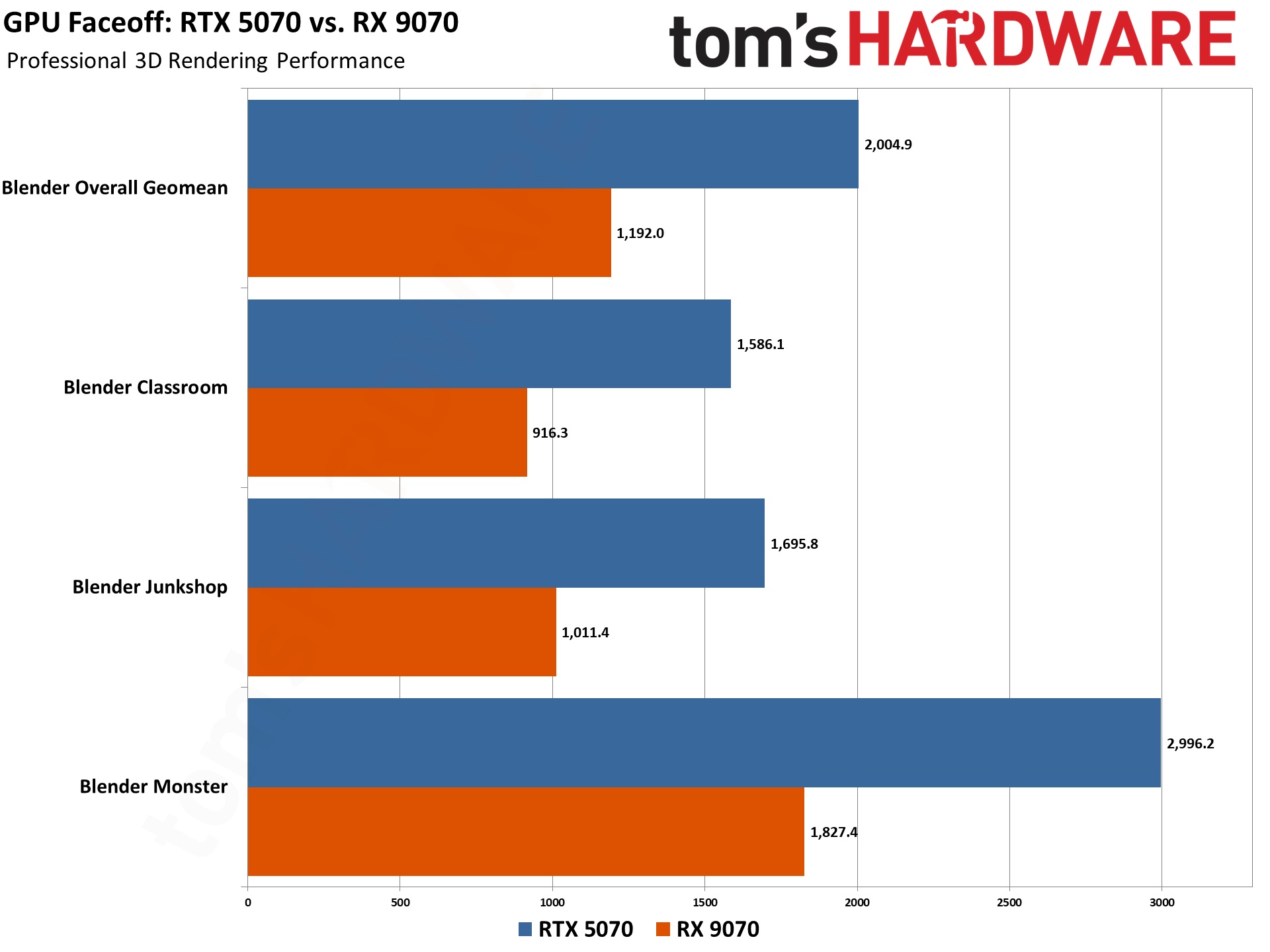
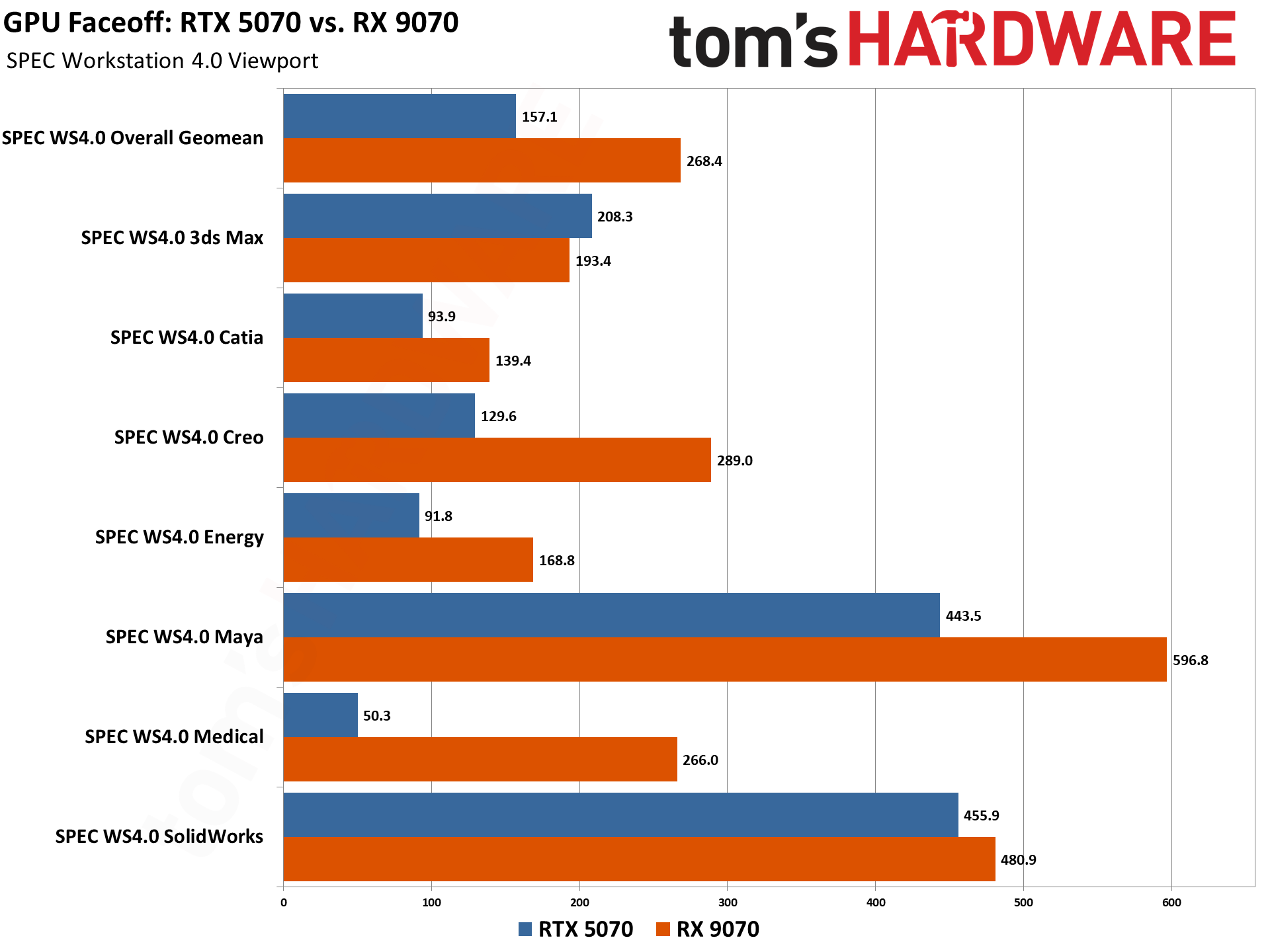
Professional Benchmarks
Overall, the RTX 5070 and RX 9070 perform very similarly in our professional benchmarks, on average. However, when diving into individual benchmarks, the differences vary significantly. Some benchmarks favor Nvidia heavily, while others favor AMD heavily.
In Blender, the RTX 5070 is 68% faster than the RX 9070 on average. In Procyon AI Vision, the RTX 5070 is 2.2x faster than the RX 9070, but in SPEC and MLPerf, the RX 9070 is just as fast as the RTX 5070 or faster, depending on the benchmark. Similarly, the RX 9070 is 70% faster than the RTX 5070 in Spec WS4.0, as indicated by our overall geomean.
🏆 Winner: AMD
The RX 9070's slight edge at 1440p and more substantial lead in 4k is enough to give it a win over the RTX 5070. Technically, the RTX 5070 would probably win if we put all the professional benchmarks together in a single geomean. But most people are going to be gaming with these cards, and that is where our priority is for this face-off.
Features, Technology, and Software
The RX 9070 and RTX 5070 are very different GPUs from a design perspective, despite sharing the same price class and competing directly against each other. The RTX 5070 is more or less a minor upgrade over the RTX 4070, featuring the same process node and a moderately improved architecture over Ada Lovelace, relying on features like x3 and x4 frame generation to provide more generational performance improvements. The RX 9070, on the other hand, is a significant upgrade over its predecessor (the RX 7800 XT at the very least), taking advantage of a more advanced GPU architecture (RDNA4) and more advanced process node to provide traditional gen-on-gen performance improvements. Memory designs are also very different between the two GPUs.
The memory subsystems on the RTX 5070 and RX 9070 arguably could hardly be any more different. The RTX 5070 relies on a moderately large 48MB L2 cache and super-fast 28 Gbps GDDR7 memory modules on a 192-bit interface to provide the GPU with enough memory bandwidth for rendering and compute tasks. The RX 9070, on the other hand, takes advantage of a massive 128 MB (L3) Infinity Cache on a larger 256-bit interface, but uses older, slower GDDR6 (not even G6X) memory modules operating at 20 Gbps to get the job done.
According to our performance benchmarks, it appears that AMD’s memory design is better suited for maintaining performance at higher resolutions. However, both are equally capable at lower resolutions such as 1080p. We saw that the RTX 5070 and RX 9070 were more or less the same in performance at 1080p, but moving up to 4K ultra, the RX 9070 took a noticeable lead. Nvidia’s implementation most likely gets overwhelmed at 4K, where data that would normally fit at 1080p (or similar) resolutions in the L2 cache (or the 12GB of VRAM) doesn’t fit at 4K. (There’s a chance other architectural differences are boosting AMD’s high-resolution performance, but it is likely that AMD’s memory sub-system is at least helping to some degree.)
VRAM capacity is another area where the RX 9070 technically outperforms the RTX 5070, with 16GB in total compared to 12GB on the RTX 5070. However, this isn't always a net win for AMD. Nvidia in the past has always had superior memory compression, which can make up several gigabytes worth of capacity deficit compared to AMD. AMD never talks about memory compression in its architectural announcements, so we're assuming RDNA4 still has an inferior memory compression system compared to Nvidia.
Compute-wise, the RX 9070 gains a slight edge over the RTX 5070, featuring six more TFLOPS of FP32 performance (36.1 vs 30.9), and 42 more TFLOPs of FP16 performance (289 vs 247). However, TFLOPs have never been a good indicator for gaming performance at all.
One of AMD’s largest achievements with RDNA4 is its drastically improved ray-tracing performance. For the first time ever, AMD’s GPUs are now going toe-to-toe with Nvidia in ray-tracing. Previously, Nvidia had a noticeable advantage in ray-tracing, mainly because it developed real-time ray-tracing rendering before AMD got on board, giving Nvidia a head start.
AMD was able to achieve ray-tracing parity thanks to significant enhancements to RDNA4. AMD has doubled the ray / triangle and ray / box intersection rates of RDNA 4 compared to RDNA 3, indicating that each RT unit in RDNA 4 is twice as powerful. This has led AMD to match Nvidia in most modern ray-tracing games.
However, there are still some pitfalls AMD needs to address. Namely, path-tracing is still a weak point for AMD and an area where Nvidia still has a huge advantage. We didn’t test any path-tracing games in our comparison here, but if you look at our review of the RX 9070 and RX 9070 XT, there is a significant performance margin between RDNA4 and competing Blackwell GPUs (to the point where previous generation RTX 40 series GPUs of the same tier are faster).
We haven’t done FSR 4 testing yet (at least at the time of writing), but other reviewers have revealed that AMD’s latest iteration of FSR is a significant leap up from prior generations and is roughly on par (if not better) than DLSS 3.x upscaling. This makes a lot of sense considering FSR 4 is AMD’s first upscaler using machine learning / AI-based upscaling just like DLSS.
However, AMD still has yet to provide a true competitor to DLSS 4, which now takes advantage of a very complex transformer AI model and has other features such as 3x and 4x frame generation, and a more optimized 2x frame generation mode, which AMD can’t compete with. AMD is also rumored to be working on a ray reconstruction competitor for FSR, but it's not out yet.
Nvidia still has a significant advantage in the software department. Not only does the Green Team have more tools at its users' disposal, such as RTX Chat, RTX Broadcast, and more, but its software is generally of better quality. Software has notoriously been a sore spot on AMD’s side, particularly for the enterprise realm, where its ROCm software suite pales compared to Nvidia’s enterprise suite of tools.
🏆Winner: Nvidia
AMD may have an advantage in pure hardware, but Nvidia still outperforms AMD in terms of path tracing or full ray tracing), and software.
RTX 5070 vs RX 9070 Verdict
| Row 0 - Cell 0 | RTX 5070 | RX 9070 |
1440p Performance | Row 1 - Cell 1 | ❌ |
4K Performance | Row 2 - Cell 1 | ❌ |
Price | ❌ | Row 3 - Cell 2 |
Features, Technology, Software | ❌ | Row 4 - Cell 2 |
Total | 2 | 2 |
In the end, depending on real-world pricing when you buy, you can't go wrong with either the RTX 5070 or RX 9070. Both GPUs offer something different to gamers, whether that's stronger raw performance or more advanced features. Sadly, availability also plays a significant factor and will inevitably be a reason gamers choose one GPU over another until the current market shenanigans are behind us.
The RTX 5070 and RX 9070 represent one of the closest competitions we've seen in the mid-range space in quite a while. In the past, even with the RX 7000 series, AMD was only the optimal choice when its GPUs were cheaper than Nvidia's counterparts. With the RX 9070, AMD has made huge strides in improving its weakest points, namely, ray-tracing and upscaling quality, to the point where the RX 9070 might be a better choice even if it's slightly more expensive than the RTX 5070 if you're primarily interested in native 1440p and 4k gaming frame rates.

Aaron Klotz is a contributing writer for Tom’s Hardware, covering news related to computer hardware such as CPUs, and graphics cards.
-
opckieran For anyone wondering about efficiency:Reply
https://www.tomshardware.com/pc-components/gpus/amd-radeon-rx-9070-xt-review/8 -
Valuables8335 So for someone who is fine with DLSS, Framegen and FSR and games at 1440p, the 5070 is probably the better option, even if it doesn't quite have the raw power of the 9070, or the 16GB (as that's only likely to be an issue at 4K). Especially as it's currently about £80 cheaper in the UK.Reply
Is that about right?
Or maybe wait for the 5070 super with 16gb? -
Jabberwocky79 Reply
Um, no, that's not what I got from the review... but granted I did read it quickly. It seems the 9070 is faster at 1440p than the 5070 in several games without needing to rely on software solutions. I think anytime you can avoid Framegen stuff, the better. But of course budget is a big factor. And if you care a lot about pathtracing, then I would go with the 5070.Valuables8335 said:So for someone who is fine with DLSS, Framegen and FSR and games at 1440p, the 5070 is probably the better option, even if it doesn't quite have the raw power of the 9070, or the 16GB (as that's only likely to be an issue at 4K). Especially as it's currently about £80 cheaper in the UK.
Is that about right?
Or maybe wait for the 5070 super with 16gb? -
King_V Reply
It kind of sounds like you want an Nvidia card regardless of the circumstances.Valuables8335 said:So for someone who is fine with DLSS, Framegen and FSR and games at 1440p, the 5070 is probably the better option, even if it doesn't quite have the raw power of the 9070, or the 16GB (as that's only likely to be an issue at 4K). Especially as it's currently about £80 cheaper in the UK.
Is that about right?
Or maybe wait for the 5070 super with 16gb? -
Flayed The 5070 is quite a bit cheaper in the UK than the 9070, it's a shame the AMD cards aren't nearer to MSRPReply -
Jabberwocky79 Reply
It is perplexing. Did Nvidia partners finally catch up on their production backlog? Or is there something else at play here? Is demand for the 9070 outpacing the 5070? (Surely not)Flayed said:The 5070 is quite a bit cheaper in the UK than the 9070, it's a shame the AMD cards aren't nearer to MSRP -
logainofhades The elephant in the room is Nvidia's failure to produce stable 50 series drivers.Reply -
Jabberwocky79 Reply
There was a time I wanted a new Blackwell card more than anything. So far my first AMD excursion in 20 years has left me with no regrets whatsoever.logainofhades said:The elephant in the room is Nvidia's failure to produce stable 50 series drivers.